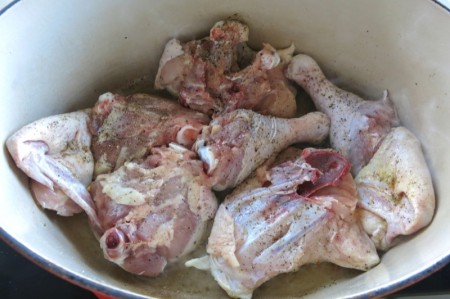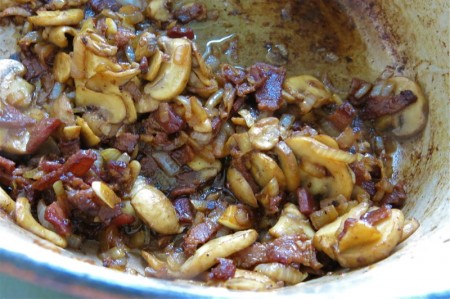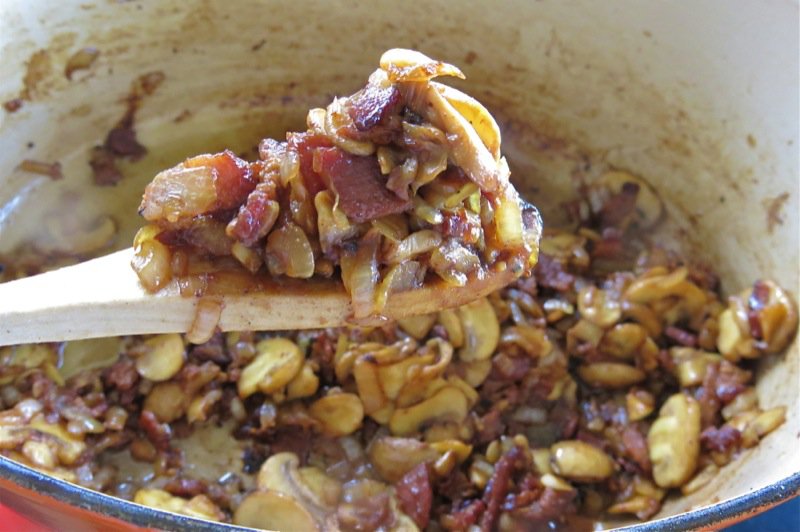Chicken in Wine doused with a buttery bacon mushroom gravy

The young and spunky Elizabeth Davis clinched her husband with baked browned pork chops layered with onions and harvest apples scented with cinnamon. I would like to hear his version of how he clinched her. These tasty chops may have sealed the deal, but Elizabeth was a great catch long before her apple scented cinnamon chops appeared on the table that evening. The accomplished young graduate of the University of Toronto with a degree in modern languages and literature had lived in France for a year, was a bilingual academic, an accomplished hostess and a fearless adventurer. That was Elizabeth in her early 20’s. Approaching 74 this month, famed Canadian food icon, Elizabeth Baird is deservedly celebrating the end of a year studded with awards recognizing her life’s work and accomplishments. Amidst a new project to produce “a little book called Setting a Fine table” of upper class 1830’s food that the volunteer historic cooks prepare in the officers mess at Fort York in Toronto she is far from resting on her laurels.

In her early 20’s, Elizabeth Baird left Canada with her husband, George, to live in England while he carried out postgraduate research at University College, London. She was there from 1964 to 1967 at the time of the British Invasion. That era in London changed music around the world forever. It also opened they eyes of a young Canadian woman living abroad and brought her to an understanding of Canadian food more from a distance than she had grasped at home in Canada. Born in Stratford, Ontario, and raised in a home with a mother who loved to cook, Elizabeth Baird reveled in her additional role as hostess and entertainer to their friends while abroad.

Once back in Canada, she has managed to have her finger on the pulse of what is happening or on the “making-it-happen button” in the Canadian food scene. An important beginning for Elizabeth was the opportunity that Jim Lorimer, personal friend and appreciative guest at Elizabeth’s London dining table, offered her. He started his own publishing company to publish his thesis and and invited Elizabeth to write a Canadian Cookbook for his new company.” He loved food and was very much a nationalist. It was clear it would be a Canadian food cookbook.” Classic Canadian Cooking: Menus through the Seasons was her first publication.

Today, I share a recipe from Elizabeth that has frequented the Baird table the past 50 years. When George and Elizabeth lived in England (1964 to 1967) Great Dishes of the World by Robert Carrier had just been published, and Elizabeth received a copy from George.”I made many dishes from the book – the daube of beef, choucroute garnie, osso bucco, cheese souffle and more – mostly for entertaining. But there was one dish Carrier called Quick Chicken in Wine that has been a standby for almost 50 years. You really don’t need a recipe for this simple chicken stew, but here is how I make it now, sometimes with wine if there’s some left in a bottle, or with broth when there isn’t. Bacon is nice for its smokiness, but not necessary.” You can see I have already made it twice. The first time, just above and below, made with a whole chicken, as that is how I buy them. The sauce was too tight; the flavour, deeply complex and restaurant quality. I surprise myself consistently, and this time round it was because I was exceedingly uptight preparing this dish. It was important to get it right. It was important to also make it magazine quality, so the promise of the dish could be tasted via the photograph. The second time, Elizabeth’s way, with skinless chicken thighs. The sauce was perfectly loose and it turned out as I can imagine it would have on the Baird table so often (first three photos). This time, I was making dinner for my family instead of Elizabeth. It is not a pretty dish, as it is stewed chicken with caramelized vegetables. Dark, saucy and textured. It is all about the aroma, the flavour, the texture and the sauce. This dish is all about home food. Canadian home food.

Young Elizabeth Davis was reared in the small agricultural town of Seabringville, a little place outside of Stratford, Ontario, very near her mother’s family farm. The area between Fullerton and Mitchell, Ontario, opened up for farming in the early 1840’s and Baird’s maternal grandmother’s family pioneered land just South of Mitchell and undertook a mixed family farm. Elizabeth’s mother’s strong work ethic and ability to produce outstanding meals with local home grown food had a profound effect upon the young Elizabeth. “My mom was a good cook. When mom went back to work (she was a nurse and they needed nurses as it was during the baby boom) our family took on different responsibilities. I always liked to cook so my sister and I took on the cooking.”
The vignettes she paints of her family as a child are evoked through her mother’s food.
Her mother, from a family of 8, had three sisters, and they all had to cook on the farm. Family dinners on the farm were relished. “Grandma would make country gravy, and it would be dark brown. City gravy was just not quite as good.” After slopping a wedge of crusty bread to sop up the gravy of this Quick Chicken in Wine dish, I understand that Elizabeth cooked to preserve those rich taste memories.
Meeting Elizabeth Baird, my Canadian Culinary hero, in Jasper last month, I found my expectations surpassed. I did not expect such warmth, candor, and humor. I did expect authenticity. Elizabeth is renown for that. She is the real deal. She walks her talk. She extended her heart with her hand. Sitting with her one late afternoon at the Jasper Park Lodge after her session with Emily Richards at Christmas in November, she sipped a latte and nursed her aching back as we talked. Completely aware that I was sitting with a famed Canadian maven recently awarded the Order of Canada (June 28, 2013) specifically for her “contributions to the promotion of Canada’s diverse food heritage, as an author and former food editor”, I was unexpectedly relaxed. Elizabeth possesses the inexplicable ability, charm and wit necessary for anyone to feel at home with her, no matter where the space or place.
There was a deeply personal connection for me during our conversation, as Elizabeth revived pivotal episodes throughout her life when a Canadian food experience moved her. Eventually, she was inspired through the global world view gained by her travels to champion Canadian cuisine. She understands the power of personal food stories and the significance of shared stories to our Culture and the future of Canadian cuisine.
“My father loved to eat and mother was a really good baker. She made particularly good pies and cakes, but was not so big on cookies.” As Elizabeth reminisced about the food of her first home, even at the end of a long day, her eyes reflected passion and glistened with the emotion such memories elicit. “Oh, we had delicious raisins. Mother would bake with really big fat raisins. She would make date custard pies and apple pies. My father really loved dried fruit. Mom came from a British [and Scottish] background which influenced our food. There were a lot of Germans in our area, too, and the Dutch Apple Pie was a [family favourite]. The pie was all about the apples. It would be cut into 6 or 8 and drizzled with whipping cream. It was a simple mixture of flour, brown sugar and cinnamon with the apples on top. I liked adding nutmeg. We would do the same with peaches and plums and rhubarb. Whatever was in season at the time.”

Emily Richards, Valerie Lugonja, Elizabeth Baird at Christmas in November
After a night of travel from the awards ceremony, and a day of presenting, we talked
We sat together a day after she attended the 2013 Taste Canada food writing awards where she and Rose Murray won in the category of general cookbooks for their co-authored Canadian classic: Canada’s Favourite Recipes, published by Whitecap Books. The awards recognize excellence in Canadian culinary publishing. This has been quite a year for Canadian food and Elizabeth with the Order of Canada, and that same night, Elizabeth was inducted into the Taste Canada Hall of Fame:
ELIZABETH BAIRD: Elizabeth Baird’s distinguished career in food began with an invitation from publisher James Lorimer to write a book about Canadian cooking. Classic Canadian Cooking, published in 1974, was her entrée into food writing. She went on to work at various newspapers, but it was her work as food editor of Canadian Living Magazine – for 20 years – that truly made her a household name. Along with magazines, there were other opportunities in radio and television – especially Canadian Living Cooks on the Food Network. And then there were cookbooks, over 30 of them in all, most notably The Complete Canadian Living Cookbook. Elizabeth is the recipient of numerous awards and honours including the Founder’s Award from Cuisine Canada, a National Magazine Award, a Silver Ladle from the Toronto Culinary Guild, and she was also named the Women’s Culinary Network’s Woman of the Year. Most recently, she was appointed a Member of the Order of Canada.

After clinching her husband with baked browned pork chops layered with onions and apples scented with cinnamon, the favourite meals that Elizabeth prepares to this day are stews, like this Quick Chicken in Wine. She no doubt revels in the complex flavours that she has learned to coax from the combination of meat, aromatics and root vegetables. Remember grandmother’s gravy? The love of stews is shared by both Elizabeth and her husband, as Elizabeth recounted a vivid childhood food memory from her mother’s kitchen: “I remember returning home from summer camp and mom had made a stew.” Elizabeth described “the fine green beans and carrots” in the lush meaty dish dripping with tasty juices. As if there, I felt the cold against the door. Cheeks rosy. The warmth of home and home food warmed and nourished cold body, bones and heart.

Elizabeth was raised on Canadian country cooking. “My mother made terrific biscuits. She never measured anything, and they were perfect, every time. She made loaves. They were all called a cranberry loaf, but it could be a date loaf or a lemon loaf or a banana loaf. I thought that when you grew up, you never needed recipes.”
The favourite foods around the Davis home? ” Well, you had to have peameal bacon.” This was said with such authority and so matter-of-factly that is was understood any Canadian would agree with this. “Mom would make a 50’s recipe: a lemon pineapple square with canned pineapple that I really liked, and a really nice walnut square. [Mom’s sister] lived in New York and taught us how to make Chili Con Carne.” I recalled learning how to make Chili Con Carne at about that same age. It is a significant memory for me, as well. The flavours were exotic and the power of the ability to create such flavour was profound.
“When I was little, you only had chicken on Sunday. That was in the late 40’s when the little 1.5-2 pound chickens came in. Then there were the friers. I would pick all the nice nuggets of chicken from the bottom of the pan.” As Elizabeth shared her food experiences, I found them paralleling my own. Just fourteen years my senior and more than a couple of thousand miles to the East, we were raised at slightly different times in different Canadian regions, yet the similarity of her food experiences and stories to my own, is profound. There is no doubt, that across this vast land, there is a culinary culture, as divergent as it is from region to region and through the beauty of our multicultural ethnicity, the overarching familiarity of Canadian country food is found in these similarities.

The first time Elizabeth identified a significant Canadian food experience was when she was at University and worked at a summer lodge. “Flossy Robinson made butter tarts with maple walnut ice cream and most guest were American. They were so surprised by them that it remained in my mind as a specific Canadian food experience.” Maple walnut ice cream. Now, that used to be a regular item in my own family home. My dad loves it to this day. There used to be four flavours of ice cream: Vanilla, Chocolate, Strawberry and Maple Walnut. This was significant. These are important stories.
Living away from Canada clarified Elizabeth’s understanding of Canadian food. “I worked in a school and was confronted in England with what “English” was. Yet, I wasn’t English; I was Canadian. My name was Davis, so no, I was English.” Being abroad laid the foundation of what it meant to be a Canadian back in 1967. Elizabeth learned that “Baking was a really serious Canadian strength…
Baking was a really serious Canadian strength.
“We did a lot of preserving when I was at home. Beet pickles, dill pickles. The nine or eleven day pickles were a favorite. “The secret was to start them immediately. The crocks were on the table and we would dip into them with the plate underneath [and draw out the pickles.] Those condiments were an important part of our winter meals. Recognizing what people served me in France and in England [underlined what Canadian cuisine was for me]. There is a generosity that comes from a farm culture with lots of food and lots of people. We always had more for others.”
Baird left teaching in 1983, though continued to teach part time, but was also “teaching cooking and doing gigs on radio, though not a lot of food writing in those days.” She had staked out Canadian as her theme long before this. Carol Ferguson, food editor of Canadian Living Magazine featured Elizabeth in 1981 with an article on Strawberry Shortcake as “in Canada we make it with biscuits.” Elizabeth Baird, Anne Lindsay, Rose Murray, Lucy Waverman, and Bonnie Stern were significant contributors to the magazine in the 80’s long before there was a test kitchen. Cookbook specials started with a couple a year, then 3 or 4, then 6. The test kitchen came in 1985. Canadian Living was a thriving business and Elizabeth was hired as the food editor when Carol Ferguson, food editor at the time, and Marg Fraser, associate food editor, found their time spent food styling and in free lance development to the point where Carol stepped out of the position.
Elizabeth worked to define and preserve Canadian food recipes within the ever changing landscape of our multicultural ethnicity within her role there and her “contributions to the promotion of Canada’s diverse food heritage, as an author and former food editor” found her an Order of Canada recipient earlier this year.
Established in 1967 by Her Majesty Queen Elizabeth II, the Order of Canada is the centrepiece of the Canadian Honours System, and recognizes a lifetime of outstanding achievement, dedication to the community and service to the nation. The Order recognizes people in all sectors of Canadian society. Their contributions are varied, yet they have all enriched the lives of others and made a difference to this country.

I didn’t expect Elizabeth to have such wit as I sat through her session at Christmas in November. Yet, as Robert Sternberg once said, “humour is restructured intelligence”, so I should not have been surprised. Her naughty little moments were just risqué enough to add that bit of unexpected zest and intrigue. Elizabeth called it “grivoise” as “the French would say” and twinkled. There was really nothing novel about the recipes presented in their session: a cheese dip, a mushroom paté, seasoned shrimp and dates stuffed with cheese wrapped with pork, yet I was actually taken aback by the taste of each recipe as that little extra je ne sais quoi…. that “somethin’ somethin’’ was added to the mix. Tested ‘til perfect and working with a recipe matters in the Canadian Living Test Kitchen and Elizabeth Baird knows flavour. Lip smackin’ pleasure. That presentation was as tasty as the food and this Baird family staple, Quick Chicken in Wine, has led me to a renewed understanding of the importance of Canadian Country food within my own life.

I do know a good chicken when I see one. I visited the farm, tasted the meat, and bought our winter supply. Grass fed, moved a couple of times a day feeding on alfalfa thriving on the richest and blackest of soils. When we have a chicken, it tastes like a chicken. Moreover, it is humanely raised and no worry about disease.

I thought I learned how to butcher a chicken from a Julia Child rerun on TV as a teen, but it was really Allan Suddaby who taught me everything I needed to know.




Elizabeth uses skinless thighs. Bone in is the way to go, but remove the skin? Vanja would lift up his plate to be searching for the missing bits of fatty goodness if I left it out.

The rest is straight forward, if you cook: brown the chicken, remove the fat, brown the bacon, remove the fat, brown the mushrooms and onions until there is no moisture left in the pan.




Add the wine or chicken stock and the browned chicken back into the pan.


Add the herbs and seasonings and simmer for about 30 minutes.






Remove the chicken and make a gravy with the bits left in the pan. Liquid gold. That is what is in the bottom of that pan. Pure liquid gold.




You can see what I mean by a tight gravy. I was too up tight myself to realize that it needed a little relaxing. Yet, it was delicious.


However, as with all good things, second time round, when I relaxed, so did the gravy. First time, Vanja and Ragan said, “This is good.” Second time, there were almost inaudible grunts and gutteral utterances and when both came up for air, there were two happy faces and four thumbs up. “Tastes like my mother’s goulash.” is the highest compliment Vanja offers. There is something universal about home food.

So, what is Canadian Food, Elizabeth? “It’s Place. It’s Season. It’s the people and the ingredients from the region. First nation ingredients are a very significant part of Canadian cuisine: corn, salmon, bison, fish, and berries.”
Advice to Canadian food writer’s and bloggers? “Cook and write about ingredients indigenous to Canada. Celebrate them. Be the link between the older culinary traditions and our new-comers and their heritage dishes and the coming together to enjoy food.”
Quick Chicken in Wine
Ingredients
- 3 lb or 1.5 kg air-chilled chicken thighs (i used one whole chicken)
- Salt and freshly ground pepper
- 1 tbsp or 15 ml olive oil
- 4 slices bacon , diced
- 1 onion , diced
- 2 cups or 500 ml sliced mushrooms
- 1 large clove garlic , sliced
- 2/3 cup or 150 ml white or red wine , or low sodium chicken broth with a splash of wine vinegar
- 1 bay leaf
- 1/2 tsp or 2 ml dried thyme
- 2 whole cloves , optional
- 1 tbsp or 15 ml butter
- 1 tbsp or 15 ml all-purpose flour
- Chopped fresh parsley
Instructions
- Trim excess fat and skin from chicken thighs; pat dry.
- Season with salt and pepper.
- Heat oil in shallow Dutch oven or high-sided skillet over medium-high heat; brown chicken on both sides.
- Transfer to plate and drain off fat.
- Fry bacon in pan until almost crisp; add onion, mushrooms and garlic.
- Fry until mushroom juices have evaporated, about 8 minutes.
- Stir in the wine, bay leaf, thyme and cloves, if using, scraping up any brown bits still in the bottom of the pan.
- Return the chicken to the pan, turning to coat it on all sides with the onion mixture. Cover the pan and bring the liquid to a simmer.
- Reduce heat and simmer until chicken is tender, about 20 to 30 minutes.
- Transfer the chicken to a warm platter.
- Blend together the butter and flour; gradually mix into the liquid in the pan.
- Simmer, stirring, until liquid thickens evenly.
- Taste and adjust seasoning. Pour over the chicken and garnish with parsley.
Notes
Note from Elizabeth:
When George and I lived in England (1964 to 1967) Great Dishes of the World by Robert Carrier had just been published, and I received a copy from George. I made many dishes from the book – the daube of beef, choucroute garnie, osso bucco, cheese souffle and more – mostly for entertaining. But there was one dish Carrier called Quick Chicken in Wine that has been a standby for almost 50 years. You really don’t need a recipe for this simple chicken stew, but here is how I make it now, sometimes with wine if there’s some left in a bottle, or with broth when there isn’t. Bacon is nice for its smokiness, but not necessary.












What a wonderful inspiration this lady is. I’m so glad you wrote about her. Thank you for that. And that chicken is definitely going to be on my list of family meals coming up!
I started to prep my grocery list today for your delicious looking chicken and then realized I have essentially made this recipe. Elizabeth Baird put it in The Complete Canadian Living Cookbook with the same recipe title. There are a few minor variations to the ingredient list but essentially the same. I am excited to be making Quick Chicken in Wine again for tomorrow’s dinner! It is the season for warm, cozy comfort food. I have so many recipes by Elizabeth Baird. She really is a Canadian food icon for me.
Your chicken looked deadly delish on Instagram, Anne!
Obviously, you added a lot more stock than Elizabeth had in the recipe sent to me, and the addition of the tomato paste was probably scrumptious, too. Yes, lots of ways to engage with this recipe.
🙂
Valerie